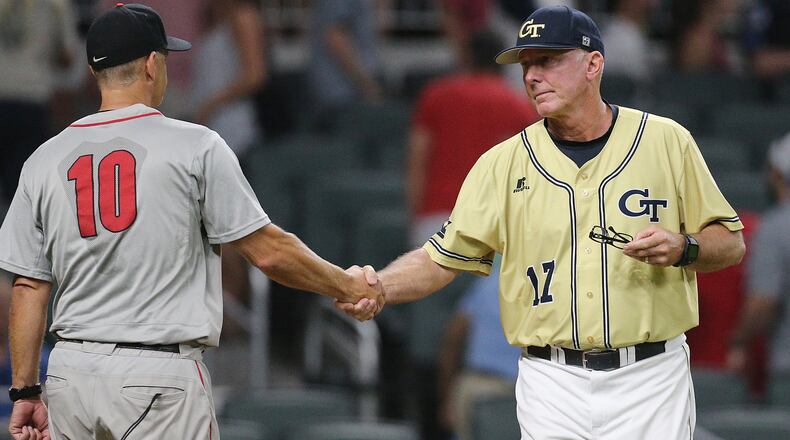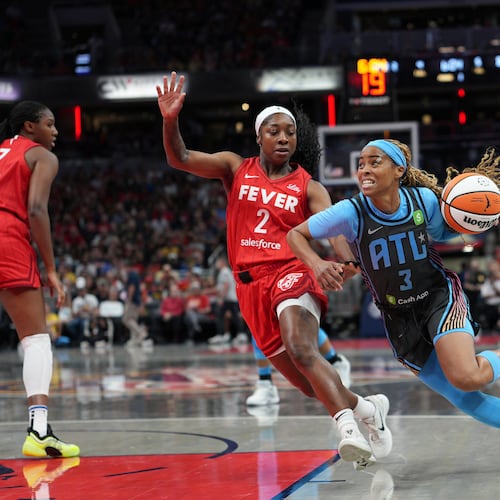The release of “Moneyball” in 2003 showed how personnel decisions could be made using data previously unknown or ignored. Since then, Major League Baseball has only increased its use of analytics and advanced technology.
Cameras capture every movement, every pitch, every swing. The resulting numbers — some of them unavailable to the public — are analyzed by teams looking for any edge they can get.
In 2021, the deluge of data extends far beyond the professional game. High school players from Georgia and across the country use devices such as Rapsodo and TrackMan as they try to impress college recruiters and professional scouts.
Rapsodo offers two portable cameras (one for hitting, another for pitching) that are placed in front of home plate. TrackMan is a radar system mounted into baseball stadiums. Both products spit out statistics such as spin rate, release point and launch angle — all ideal for improving pitch or swing design.
Over 90% of Division I baseball programs own a Rapsodo, according to the company’s director of diamond sports Seth Daniels. Georgia, Georgia Tech and Georgia State all have at least one Rapsodo unit.
When the COVID-19 pandemic disrupted high school games and tournaments, technology became an even more important tool for players trying to get noticed. Twenty-three of the 29 MLB first-round draft picks in 2020 had Rapsodo data on file, Daniels said.
A new era in college baseball
Power Five coaches in particular want to see how recruits fare in new-age metrics, said Phil Kerber, Prep Baseball Report’s director of scouting in Georgia. Prep Baseball Report is an amateur scouting service that began using TrackMan in 2020.
“We’re trending towards more forward thinking as far as technology,” Kerber said. “There are certain coaches that will call and ask about spin rates.”
Count Tech’s Danny Hall as one of those coaches. He oversees a program that completed a renovation to its stadium in late April. The new section includes a “lab” replete with all the fancy technology: Rapsodo, TrackMan, Edgertronic slow-motion cameras and even a biomechanical tracking device called Qualisys.
“It’s about as high-tech as you can get,” Hall said.
One big benefit of coaching at an institute of technology: There is no shortage of students willing to help crunch the data. Tech has a team of six to eight students working alongside director of operations Nick Ascue, Hall said.
Credit: Danny Karnik
Credit: Danny Karnik
The technology will be most useful when freshmen first arrive on campus, Hall said. Coaches can almost immediately tweak players’ flaws found in the motion capture cameras.
These days, those freshmen likely will be accustomed to the camera’s gaze. Showcases are increasingly using advanced technology as part of their packages. Hall said high spin rates — or the number of revolutions per minute after a pitcher’s release — can get a high school recruit noticed.
That’s exactly what happened with Simon Aluko, a pitcher for Georgia Premier Academy. He switched positions late in high school, and colleges couldn’t see him perform in-person. The NCAA doesn’t allow coaches to visit recruits because of the pandemic. The moratorium will be lifted June 1.
Charleston Southern gave Aluko a scholarship offer in part because of his Rapsodo report. The team’s coach called him and said he was impressed with Aluko’s fastball spin rate.
“Technology was the main factor in my recruiting,” Aluko said. “(Coaches) couldn’t come out, so we just showed them videos, showed them Rapsodo reports. It really changed the game for me.”
Not all are sold on the power of analytics in recruiting. Georgia baseball coach Scott Stricklin said he misses scouting games in-person.
“There’s a lot of things that numbers can’t tell you,” Stricklin said. “They can’t tell you what kind of teammate they are, and they can’t tell you how hard they play.”
Social media plays a role, too
Rob Friedman, a businessman and former lawyer based in Decatur, spends hours of his free time each day retweeting videos from high school prospects. Baseball fans know him as the Pitching Ninja, the name of his Twitter account where he shares short video clips.
The self-taught pitching coach expanded his social-media influence in January 2019 by starting Flatground, a Twitter account filled with videos of young pitchers shot from behind chain link fences. The pitchers have to include several facts in their tweet, including GPA.
But critically, they don’t need to spend money. The only investments required are a net, radar gun and smartphone camera. Friedman became discouraged with the steep price associated with players trying to make it to the next level while parenting his son Jack.
Now a pitcher at Tech, Jack played on a travel baseball team. It cost thousands of dollars. Jack also attended showcases, where entry fees alone can exceed $500. Friedman could afford it. He knew others couldn’t.
“People would rather play other sports than ask their parents for that,” Friedman said.
Friedman’s social-media posts have benefited some players, he said. D.J. Snelten, a pitcher in the Chicago Cubs organization, considered retiring before Friedman shared a pitching video of his, prompting renewed interest from clubs.
Still, social-media videos lack context. Several professional scouts declined to be interviewed for this article, but prospect expert Jim Callis said they don’t rely on social media as an evaluation tool. The self-reported speed of a pitch isn’t trustworthy, Callis said.
“I don’t think there’s any degree of trust in the social-media stuff,” said Callis, a journalist who helps build MLB.com’s annual list of top draft prospects. “It’s more just an, ‘Oh, that’s curious’ type of thing.”
When a player uses Rapsodo, they receive video and data. Unlike a social-media post, both are verified through a network of trained coaches.
As the coach at Tech, Hall said he frequently relies on Rapsodo’s national player database. He believes data reduces the need for expensive showcases. Daniels, the Rapsodo employee, said showcases aren’t going away, but Rapsodo’s data can paint a fuller picture of a player.
Braves partner with Rapsodo
The Braves partnered with Rapsodo in time for the third annual 44 Classic, a game meant to promote minority high school baseball prospects in the Southeast. It is named after Hank Aaron’s jersey number.
Aluko pitched an inning in that game at Coolray Field last November. His performance was monitored and analyzed by the Rapsodo camera, which was on the field throughout the game.
Through the Braves partnership, 10 historically Black colleges and universities received a Rapsodo. Florida A&M and Grambling State also used it during the March HBCU Classic. Now the 10 programs are on equal footing with the bigger budget schools. Without the partnership, Daniels said each HBCU would have had to pay more than $10,000 each.
Access to technology matters, Kerber said.
“It’s such a cutthroat business being a college coach, and you always have to be winning,” said Kerber, the director of scouting at Prep Baseball Report. “Sometimes those advanced metrics are going to be the difference between a stud or a dud.”
About the Author
Keep Reading
The Latest
Featured





